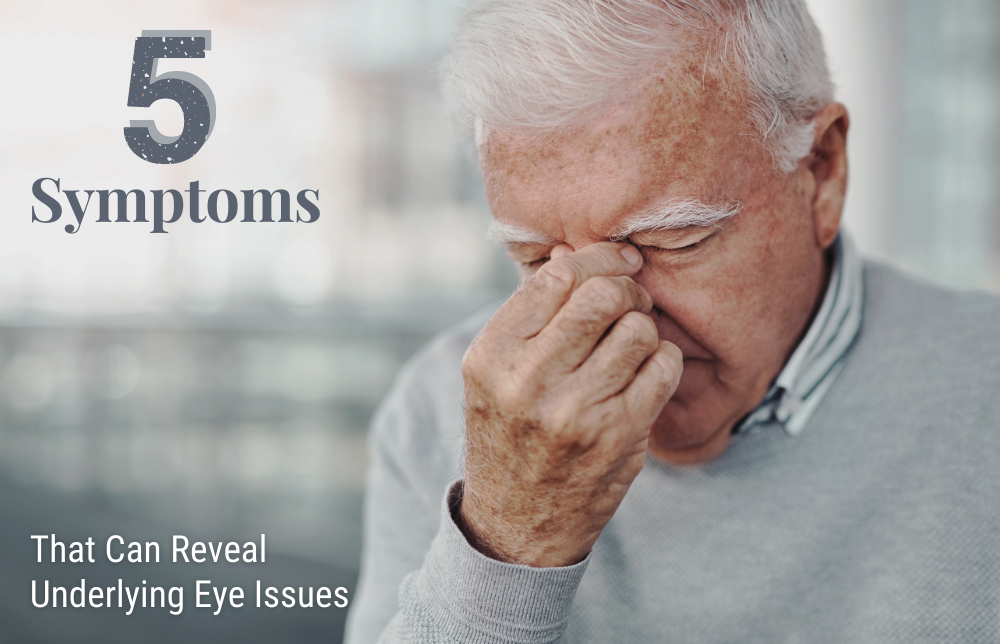
5 Issues for Aging Eyes & What You Can Do About Them
January 3, 2022
Our eyes undergo significant changes as we get older. Aging eyes can spur weakness for vision. Recognizing and diagnosing symptoms early can keep our eyes healthy. While some issues can only be detected with an eye exam, there are many conditions that present symptoms that you can recognize and, with your eye doctor, work to treat.
Issues for the Aging Eyes and What They Can Mean
- Cloudy Vision
Developing cataracts is common in older people. Almost 20% of adults over the age of 65 have experienced a cataract. This eye condition becomes apparent when darkening and clouding occur over the eye lens, subsequently obstructing vision.
Cataracts typically form gradually. When cataracts grow large and thick and block vision, the affected senior requires surgery to have them removed. A common surgical procedure removes the clouded lens and replaces it with a custom intraocular lens, restoring normal sight to a healthy eye.
- Sudden Eye Pain
People who have diabetes, high levels of near-sightedness (myopia), or a family history of glaucoma are at a high risk for developing the condition. While the most common form of glaucoma does not show symptoms other than vision loss, a rare type, called acute angle-closure glaucoma, does have symptoms, including eye pain, nausea, redness, and severe headaches. Acute angle-closure glaucoma is considered a medical emergency and should be treated ASAP.
Glaucoma is a serious condition because it can severely damage the eye’s optic nerve. People in the high-risk groups for glaucoma should undergo a dilated eye exam every two years for any signs of damage.
- Seeing Floaters
A separation of the inner and outer layers of the retina signifies retinal detachment. Symptoms that accompany retinal detachment include seeing spots or light flashes, dark shadows in the field of vision and experiencing distorted, underwater-like vision. Surgery is required to correct retinal detachment and restore vision.
- Tenderness at the Temples
Temporal arteritis may be the underlying issue when severe headaches, pain with chewing and tenderness along the temples occur. Bodily symptoms may include scalp tenderness, chronic fever and shoulder or hip weakness. These symptoms may be followed by permanent vision loss.
- Vision Loss
Noticing symptoms like blurry distance or reading vision? If you require brighter lights to see nearby objects, have difficulty recognizing people’s faces, and see blurry and/or spots in your central field of vision, this could relate to age-related macular degeneration, a condition that destroys parts of the eye’s retina.
How To Protect Your Eyes
Annual eye doctor check-ups are important because it gives you the chance to discuss with your ophthalmologist any changes of vision you’re experiencing and for them to examine your eyes and detect things you may not be able to. Eye conditions that are caught in the early stages can often be effectively treated. INRTA has a Vision Plan that covers everything from checkups to new eyewear and prescription lenses and more. Sign up now.
RECENT POSTS
An Ambulance Trip Is Stressful: With MASA, the Cost Doesn’t Have to Be
People who require an emergency ambulance trip frequently ask the same question upon receiving the bill: “Why was the
Read More
AMBA’s Essential Insights in Dental Health: Understanding Cavities
Have you ever experienced pain or noticed persistent sensitivity in your teeth? You might have a cavity. Cavities are common,
Read More
Keep “Looking” Your Best: The Unique Eye Health Challenges for Women Over 55
March is Women’s History Month, a time to celebrate women's contributions to American history and society. It’s
Read More

Leaving Your Home To A Loved One
If you’re like many people, your home represents more than just financial value. As the saying goes, "Home is where the
Read More

